It’s one of the fastest-growing plants in the world. It’s used for buildings, dishes, musical instruments. It’s food for animals and people. And there are over 45 types at Point Defiance Zoo & Aquarium.
We’re talking bamboo, that leggy, elegant plant known for both lush garden vibes as well as gardener headaches if it gets out of hand. It’s a crucial element of Asian forests, and it’s one of the things that makes the Zoo’s Asian Forest Sanctuary habitat area so immersive and realistic – and yummier for our animals, too.
Even better, World Bamboo Day is September 18th, and our horticulturalist leads a Bamboo Garden Tour on December 3, just when everyone’s looking for a tropical rainforest escape.
But the really cool thing about our bamboo is all the different varieties: spanning colors, sizes and shapes, and named after animals from tigers to koi. Here’s your walk-around guide to Zoo bamboo.
NOTE: All bamboos described below have ground labels for easy identification.
First, an introduction
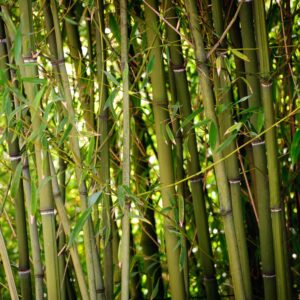 Bamboos are evergreen perennial flowering plants in the subfamily Bambusoideae of the grass family Poaceae. There are over 1,000 types in the world. Most are native to tropical and warm temperate regions, but you’ll also find some in cool mountainous areas and highland cloud forests.
Bamboos are evergreen perennial flowering plants in the subfamily Bambusoideae of the grass family Poaceae. There are over 1,000 types in the world. Most are native to tropical and warm temperate regions, but you’ll also find some in cool mountainous areas and highland cloud forests.
Bamboos are some of the fastest-growing plants in the world, due to a unique rhizome system. Some species can even grow 36 inches over 24 hours – that’s an almost-visible 1.6 inches per hour! Bamboo has a higher specific compressive strength than wood, brick or concrete, and a specific tensile strength to rival steel, so it’s not a surprise that it’s highly valued as a building material.
Plus, bamboo shoots are also edible for humans, and plenty of animals love the leaves (most famously pandas). So it definitely helps to have it around a zoo: We cut all the Phyllostachys species as leafy browse for our animals, says horticulturalist Bryon Jones. Let’s start walking!
South Pacific Aquarium – Timber!
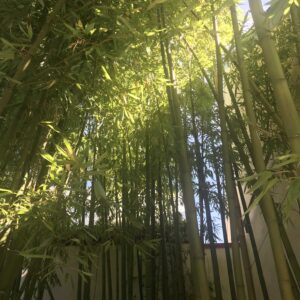
The first place you’ll notice our bamboo is flanking the entrance to the South Pacific Aquarium (temporarily closed for renovations). A majestic stand of Chinese Timber bamboo (Phyllostachys vivax) towers over the building’s roofline, the culms (stems, or trunks) as thick as pillars. Tap them, and they ring with a drum-like sonority. And yes – as the name implies, this is one of the massive bamboos used for construction.
Elephant Barn – Nude and Golden
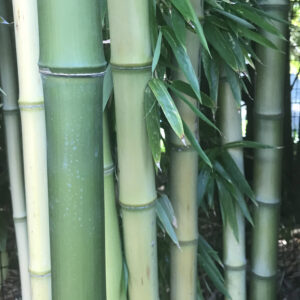
Part of the enticing charm of bamboo are its many names. Across the pathway from the elephant barn are two seductive species: Golden Vivax (Phyllostachys vivax ‘Aureocaulis’), with tall, buttery-yellow culms, and Nude Sheath bamboo (Phyllostachys nuda), with pale-green culms as smooth as – well, you get the idea.
Clouded Leopard Camouflage
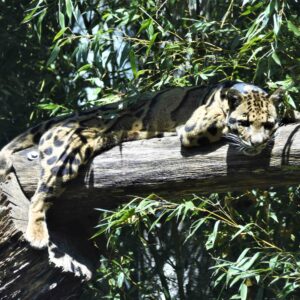
Clouded leopards love to hide up high, and we’ve given them plenty of bamboo for that! Inside their habitat, look for the lush leaves of Yellow Grove bamboo (Phyllostachys aureosulcata) and Golden Vivax (Phyllostachys vivax ‘Aureocaulis’). Look hard enough and you’ll spot a clouded leopard, too!
Elephant Poolside Snacks
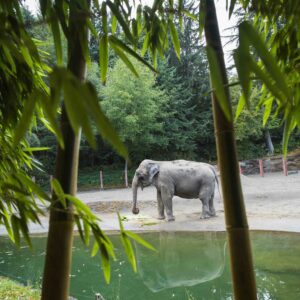
Yes, elephants love bamboo. Our elderly elephant Suki does too, but at her age the tough stems aren’t good for her teeth, so she gets other browse like banana leaf. But there’s plenty of bamboo growing right by her pool: low-clumping Dwarf Fernleaf (Pleioblastus distichus) sheltering under the towering golden culms of Kimmei Vivax (Phyllostachys vivax ‘Huangwenzhu Inversa’), and the rare, knobbly-noded Walkingstick bamboo (Chimonobambusa tumidissinoda).
Waterfall, Temple and Forest
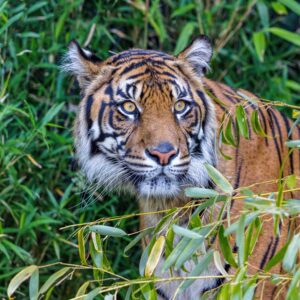
A bamboo temple for tigers? Why not? Framing our large waterfall habitat (often occupied by a regal Sumatran tiger) is concrete that imitates Asian temples – and inside the habitat are the thick fronds of temple bamboo (Semiarundinaria fastuosa). Its Latin name means “tall and stately,” and with its ability to create a dense screen, that makes it highly appropriate for the Japanese temples it often surrounds.
Asia pathway: Culms, Leaves and Shoots
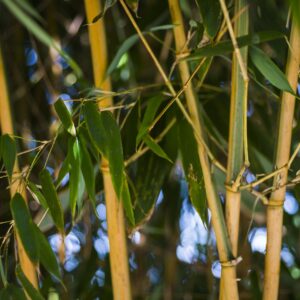
Between habitats along the Asian Forest Sanctuary pathway are several bamboo species that grab attention with leaves and shoots. On the right, Shiroshima (Hibanobambusa tranquillans ‘Shiroshima’) sends zig-zagging culms of dark green up into big leaves variegated with white stripes. Further along, Harbin (Phyllostachys aureosulcata ‘Harbin’) leaves are massive and low to the ground, shot through with gold. And nearby Sweetshoot (Phyllostachys dulcis) boasts thick green culms ringed with creamy stripes, and tasty edible shoots early in spring. (But please don’t eat ours.) Keep an eye out for Yellow Grove (Phyllostachys aureosulcata) as well, with its slender, zig-zagging culms of pale gold.
Asia pathway: From Tiger to Koi
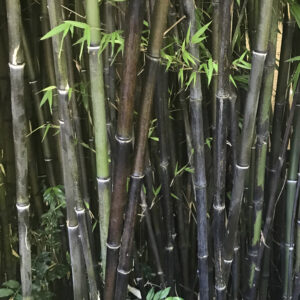
As you wander down the last stretch of the Asia pathway, you’ll pass between tall flanking forests of temple bamboo and golden vivax. But watch out – hidden down by the kiosk is a tiger! Phyllostachys nigra ‘Bory’, or Tiger bamboo, has culms of chocolate-brown and mint-green, all with a tiger-eye white stripe at each node. Finally, try to guess how Koi bamboo (Phyllostachys aurea ‘Koi’) got its name. Is it the knobbly, bony culms? Or their stripes of grass-green on yellow? And back at the elephant pool you’ll probably see what Fishpole bamboo (Phyllostachys aurea ‘Flavescens Inversa’) is named after.
Grow Your Own Bamboo Forest
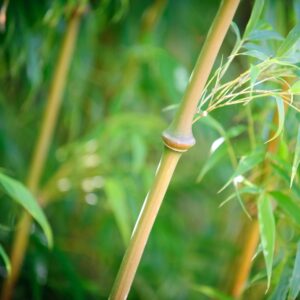
Tempted to grow your own Asian bamboo forest at home? Take some tips from our horticulturalist Bryon Jones.
- Bamboo is actually fairly easy to grow in the Pacific Northwest – but make sure you choose the right kind for your garden. Some are upright, some lean; some are tall and some short. Find out before you buy and plant.
- The other big consideration about bamboo is whether it’s “running” or “clumping”. Running bamboo does exactly that – it sends runners underground to pop up in new places. You may want this, or you may not. Most Zoo bamboo species are running, so need routine trimming, says Jones. Those types can benefit from being planted in an area with barriers for containment. Clumping bamboo spreads more slowly
- Looking for more bamboo types? Find southern hemisphere species in our Southern Borders area, up near Kids’ Zone. We have so many cool ones here at the Zoo: Corduroy, candy cane, walking stick, incense, water, arrow and pygmy bamboo, to name a few.